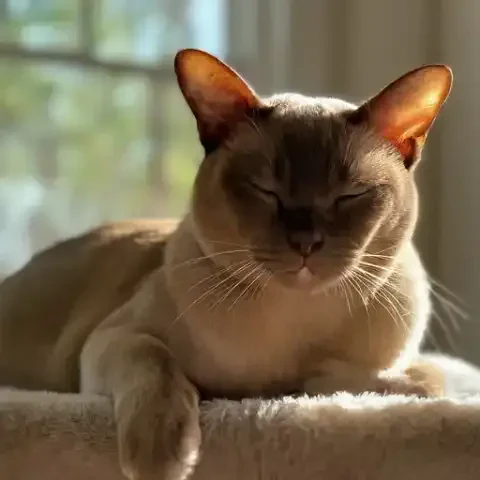We often paint them with broad strokes: aloof, independent, mysterious. The internet memes only reinforce it – cats as tiny, furry overlords, indifferent to human affection, motivated solely by food and naps. Walk into any pet store, and you'll find "independent cat" emblazoned on food packaging, further cementing the stereotype. We joke about cats being untrainable, driven purely by instinct, creatures of pure, feline… well, whatever it is that cats are supposed to be, which is often perceived as enigmatic at best, and cold-hearted at worst. Perhaps you’ve experienced it yourself: the blank stare when you call their name, the sudden, inexplicable zoomies at 3 AM, the way they seem to tolerate your presence rather than actively enjoy it. It’s easy, in these moments, to fall back on the convenient label: “cats are just cats.”
But these simplified portraits, these readily available stereotypes, are not only inaccurate, they're profoundly limiting. They are human-centric projections, misunderstandings filtered through our own dog-loving, pack-animal-oriented worldview. These labels, however humorous or relatable they might seem at first glance, prevent us from truly appreciating the depth and complexity of feline nature. They box cats into a corner of our understanding, preventing us from seeing them for the intelligent, social, and emotionally rich creatures they truly are. This article aims to peel back the layers of feline mystique, to discard the well-worn clichés, and to delve into the “real nature” of cats. We will explore their sensory world, so vastly different from our own, dissect their intricate social dynamics, reveal their often-overlooked cognitive abilities, and unpack their surprising emotional depth. Ultimately, we seek to understand and celebrate these fascinating, frequently misunderstood, and undeniably captivating creatures for who they truly are, beyond the stereotypes, beyond the memes, and beyond the surface purr.
To begin to understand a cat, you must first understand that they inhabit a sensory universe vastly different from our own human-centric reality. We, with our visually dominant world, often struggle to grasp the sheer sensory symphony that a cat experiences daily. Their noses, for instance, are not just cute, twitching appendages; they are sophisticated scent-detecting powerhouses, far surpassing our own comparatively blunt olfactory instruments. Imagine a world painted in smells, where every scent is a distinct brushstroke, creating a rich and nuanced tapestry of information. This is the world of the cat. Scent is their primary mode of communication, their way of navigating, and their primary source of environmental information. They possess the vomeronasal organ, or Jacobson's organ, located in the roof of their mouth, allowing them to "taste-smell" pheromones, those subtle chemical messengers that are largely imperceptible to us. Ever watched your cat wrinkle their nose, slightly open their mouth, and seem to… grimace at a particular scent? That's the Flehmen response, their way of drawing air across this specialized organ, deeply analyzing the complex chemical information contained within. Scent marking, through scratching, spraying (though hopefully not in your living room!), and rubbing, is their way of leaving messages, of claiming territory, of communicating social status, and even of bonding with you by subtly mixing your scents.
Their hearing, too, operates on a different plane. Cats can hear a much wider range of frequencies than humans, especially in the higher registers. This isn't just about being able to detect the crinkle of a treat bag from across the house (though, let's be honest, that's a significant advantage). It's about their ability to pinpoint the rustle of prey in dense undergrowth, to detect the ultrasonic calls of rodents, and to navigate their environment with an auditory acuity that is simply beyond our human capacity to fully comprehend. Those ears, constantly swiveling and rotating independently, are not just adorable; they are sophisticated directional antennas, allowing them to triangulate the precise location of even the faintest sound. This acute hearing makes them incredibly sensitive to changes in their environment, reacting to sounds we might not even register, explaining their seemingly "jumpy" nature and their often-unexplained reactions to the seemingly silent world around them.
And then there's vision. Cat vision, often romanticized as "night vision," is indeed adapted for low-light conditions, but it’s different from our human vision in many fascinating ways. They possess a tapetum lucidum, that reflective layer behind the retina, which acts like a mirror, bouncing light back through the photoreceptor cells and enhancing their ability to see in dim light conditions – hence those mesmerizing, glowing eyes in the dark. They also have a higher concentration of rod cells, which are sensitive to motion and low light, compared to cone cells, which are responsible for color vision and detail in bright light. This means cats excel at detecting movement, especially in their peripheral vision, making them highly attuned to the slightest flicker of prey. However, their color vision is less vibrant than ours, and their visual acuity, sharpness of detail, is lower, especially at a distance. The world, to a cat, may be less about sharply defined edges and vibrant colors, and more about subtle movements, shifting shadows, and the nuanced interplay of light and dark. Their whiskers, those elegant facial adornments, are not mere decorations; they are highly sensitive tactile organs, extensions of their sense of touch. Each whisker is packed with nerve endings, acting as sophisticated sensory tools, helping them navigate tight spaces, assess openings, and understand their immediate environment in a way that complements their vision, especially in close quarters and low light. Think of them as furry, flexible rulers, constantly measuring and mapping the world around them.
These heightened senses, this fundamentally different sensory experience, profoundly influences feline behavior. It explains why cats are so sensitive to changes in their environment, reacting to subtle sounds, new smells, and shifts in light and shadow that we might completely miss. It shapes their exploration, driving their curiosity to investigate every rustle, every scent trail, every minute change in their territory. It informs their hunting strategies, relying on stealth, keen hearing, and motion detection to locate and capture prey. And it even impacts their social interactions, with scent playing a crucial role in communication and bonding. To truly understand a cat, we must strive to appreciate their world as they perceive it, a world richly layered with sensory information far beyond our own human experience.
Moving beyond the sensory realm, let's tackle another pervasive feline stereotype: the aloof, solitary cat. While it's true that cats are not pack animals in the same way as dogs, clinging to complex hierarchical social structures, the idea that they are inherently asocial, independent to the point of isolation, is a gross oversimplification. The “independent cat” meme, while amusing, obscures a far more nuanced social reality. Yes, cats are solitary hunters, evolved to stalk and ambush prey alone. But solitary hunting doesn’t automatically equate to a solitary existence. In fact, cats are surprisingly social creatures, capable of forming complex communication systems and strong social bonds, both with their own kind and, surprisingly, with us humans. Their communication repertoire is far richer and more varied than simple meows. While meowing is often directed primarily at humans (a learned behavior, likely developed to manipulate us effectively), cats communicate with each other through a subtle yet sophisticated language of vocalizations, body language, and scent.
Beyond the familiar meow, cats employ a wide array of vocalizations – purrs, hisses, growls, chirps, trills, yowls – each carrying nuanced meanings. A purr, for example, isn’t just an indicator of contentment; it can also be a self-soothing mechanism when stressed or injured. A hiss is a clear warning signal, while a growl denotes aggression or defensiveness. Chirps and trills, often directed at prey or during playful interactions, express excitement and anticipation. And yowls, well, yowls can mean anything from loneliness to territorial disputes to simply announcing their presence to the neighborhood in the middle of the night (much to the chagrin of their human companions). Body language is another crucial element of feline communication, a silent ballet of subtle cues and postures. The position of their tail – held high, twitching, puffed up, tucked between legs – speaks volumes about their mood and intentions. Ear position – forward, flattened, swiveling – indicates attention, fear, or agitation. Body posture – relaxed, tense, arched, crouched – conveys confidence, anxiety, or predatory focus. Even facial expressions, often overlooked in cats, contribute to their communication, with subtle shifts in whisker position, eye shape, and mouth posture conveying a range of emotions, from contentment to fear to aggression. Scent marking, as mentioned earlier, is integral to feline social life. Pheromones deposited through urine spraying, scratching, and rubbing act as olfactory bulletin boards, conveying information about territory boundaries, social status, reproductive status, and individual identity. Facial rubbing, in particular, is a key bonding behavior, both between cats and with humans. When a cat rubs their face against your legs, they are not just being affectionate; they are actively depositing pheromones from scent glands in their cheeks and forehead, essentially marking you as “safe,” “familiar,” and “part of their social group.”
And while they may not form packs like wolves or prides like lions, cats in multi-cat households and feral colonies do establish social structures, often forming loose, flexible hierarchies and cooperative relationships. Observational studies of feral cat colonies have revealed complex social dynamics, including cooperative kitten rearing, shared territories, and even alliances and rivalries between individuals and groups. And contrary to the stereotype of cold indifference, cats are demonstrably capable of forming strong social bonds, both with other cats and with their human companions. Bonded pairs of cats groom each other, sleep curled together, and engage in mutual scent marking, exhibiting clear signs of affection and attachment. Cats actively seek out human interaction, rubbing against legs, purring in laps, soliciting petting, and engaging in playful interactions. They exhibit signs of separation anxiety when their human companions are absent, and demonstrably grieve the loss of feline or human companions, exhibiting changes in behavior, appetite, and activity levels. The “aloof” cat stereotype, while perhaps applicable to some individuals, paints an incomplete and often inaccurate picture of the social reality of felines. They are not solitary hermits; they are complex social beings with intricate communication systems and a capacity for deep and meaningful bonds, proving that beneath the independent exterior lies a surprisingly social heart.
Another facet of the “real nature of cats” often misunderstood, and frequently mischaracterized as mere instinctual programming, is their deeply ingrained predatory drive. We often see it manifested in their playful antics – batting at toys, chasing laser pointers, “attacking” our ankles from beneath the sofa. But hunting for cats isn't just about obtaining food; it's a deeply fundamental, intrinsically rewarding aspect of their being, woven into the very fabric of their feline nature. Even well-fed domestic cats, who have never known hunger, retain this powerful predatory instinct. It's not a learned behavior; it's an innate drive, honed over millennia of evolution, shaping their physiology, their senses, and their very motivations. To deny this instinct, to attempt to suppress or ignore it, is to misunderstand a core element of what makes a cat a cat. Play, for cats, is not simply frivolous amusement; it’s practice predation in action. Those playful stalks, chases, pounces, and “kills” of toys are not random bursts of energy; they are miniature hunting sequences, honed and perfected through generations of successful predators. The way a cat stalks a toy mouse, body low to the ground, tail twitching in anticipation, ears swiveling to pinpoint its location, mimics the precise movements of a wild cat stalking prey in the savanna. The sudden pounce, the triumphant batting of the "prey" toy, the ritualistic “killing bite” – these are all essential components of the feline hunting repertoire, practiced and refined in the safe confines of our living rooms.
Play is not just fun for cats; it’s essential. It provides vital mental stimulation, keeps their senses sharp, hones their coordination and reflexes, and allows them to express a fundamental aspect of their feline identity. Depriving a cat of play opportunities is akin to depriving them of a crucial outlet for their natural instincts, potentially leading to boredom, frustration, and behavioral issues. So, how do we, as responsible cat companions, channel this powerful predatory drive appropriately in a domestic setting? The key is enrichment. Providing enriching play opportunities that mimic the natural hunting sequence is crucial for a cat's physical and mental well-being. Interactive play sessions, using wand toys to simulate the erratic movements of prey, are invaluable. Puzzle feeders, challenging cats to “hunt” for their food by manipulating objects or solving simple puzzles, tap into their foraging instincts and provide mental stimulation. Even simply providing appropriate scratching surfaces allows them to engage in scent marking and claw maintenance behaviors that are intrinsically linked to their territorial and hunting drives. Understanding the hunter within your cat isn’t about encouraging them to decimate local wildlife (please keep your cats indoors or supervised outdoors!). It’s about recognizing and respecting this fundamental aspect of their nature, providing appropriate outlets for their instincts in a safe and controlled way, and appreciating the fascinating evolutionary heritage that shapes their every playful pounce and contented purr.
Finally, let's dismantle the persistent, and frankly insulting, myth of the purely “instinct-driven” cat, the automaton of fur and whiskers, devoid of true intelligence. While instincts certainly play a significant role in feline behavior, to dismiss cats as simply “instinct-driven” is to completely underestimate their cognitive abilities. It’s a convenient, human-centric dismissal, implying that because feline intelligence manifests differently from our own (or perhaps more pertinently, from canine intelligence, which we often use as a benchmark), it is somehow less valid, less complex, less… real. This is simply not the case. Cats are intelligent creatures, capable of learning, problem-solving, and adapting to complex environments, exhibiting a cognitive sophistication that often goes unrecognized, precisely because it doesn’t always align with our preconceived notions of “intelligence.” Evidence of feline intelligence is readily apparent, if you know where to look and what to look for. Consider their problem-solving skills. Cats are masters of navigating complex environments, figuring out intricate puzzles (often of the “how to open this treat puzzle” variety), and demonstrating impressive spatial reasoning. Watch a cat patiently work at a door handle, manipulate a latch, or figure out how to access a forbidden countertop – these are not simply random actions; they are demonstrations of problem-solving, planning, and a surprising level of cognitive flexibility. Puzzle feeders, designed to challenge cats to access food rewards by manipulating levers, drawers, or hidden compartments, are not just enrichment tools; they are opportunities to witness feline problem-solving intelligence in action.
Learning and memory are also well-documented feline cognitive abilities. Cats are capable of learning routines, recognizing patterns, remembering people and places over long periods, and even responding to basic training cues. While they may not exhibit the same eager-to-please obedience as dogs, cats are certainly trainable, particularly when motivated by food or play rewards. Clicker training, a positive reinforcement method using a clicker sound to mark desired behaviors, has proven remarkably effective for cats, demonstrating their capacity for learning through association and reward. Spatial reasoning and object permanence, fundamental aspects of cognitive understanding, are also well-developed in cats. They understand that objects continue to exist even when hidden from sight, a concept known as object permanence. Watch a cat meticulously track a toy as it disappears under furniture, then confidently emerge on the other side, anticipating its reappearance – this is not just instinct; it’s spatial reasoning and an understanding of object permanence in action. Understanding feline learning styles is key to unlocking their cognitive potential. Positive reinforcement methods, rewarding desired behaviors with treats, praise, or play, are far more effective than punishment-based approaches, which are not only ineffective but can damage the bond between cat and human. Patience, consistency, and a deep understanding of feline motivations are crucial for successful training. Cats are often motivated by food, but also by play, attention, and the satisfaction of solving a puzzle or mastering a new skill. To dismiss cats as simply “instinct-driven” is to ignore the wealth of evidence demonstrating their intelligence, their capacity for learning, and their sophisticated problem-solving abilities. Feline intelligence may not always manifest in ways that readily conform to human expectations, but it is undeniably present, a subtle, often understated, yet remarkably powerful cognitive force, shaping their interactions with the world and enriching the lives of those who take the time to truly understand it.
Finally, let us delve into the often-overlooked emotional depth of cats, dispelling yet another harmful and inaccurate stereotype: the emotionless feline, the creature of cold indifference, incapable of true feeling or deep attachment. This is perhaps the most damaging of all feline stereotypes, perpetuating the myth of the aloof, uncaring cat and hindering our ability to connect with these complex emotional beings on a deeper level. While feline emotional expression may be more subtle, more nuanced, less overtly demonstrative than canine emotional displays (tail wags and slobbery kisses, anyone?), cats experience a wide range of emotions, exhibiting joy, contentment, fear, anxiety, stress, frustration, sadness, and even grief, with a depth and complexity that often surprises those who only perceive them through the lens of outdated stereotypes. The growing body of scientific research into animal sentience and emotions is increasingly recognizing the rich emotional lives of cats, moving beyond simplistic instinct-based explanations of their behavior and acknowledging their capacity for genuine feeling. Positive emotions in cats are readily observable, if you know what to look for. Purring, often associated with contentment, is a clear expression of pleasure and well-being. Kneading, that seemingly odd behavior of rhythmic paw pressing, is often interpreted as a comfort behavior, harking back to kittenhood and the soothing act of kneading at their mother’s belly to stimulate milk flow. Playfulness, curiosity, and relaxed body postures – soft eyes, slow blinks (the feline equivalent of a loving gaze), relaxed whiskers – all indicate a cat experiencing positive emotions, feeling safe, secure, and content in their environment.
Negative emotions are also a very real part of the feline experience, expressed through a variety of behavioral and physiological cues. Fear and anxiety are often manifested through hiding,逃避, hissing, flattened ears, dilated pupils, and a tense body posture. Stress can manifest in subtle ways – changes in appetite, overgrooming, increased vocalization, or changes in litter box habits. Frustration, often stemming from unmet needs or thwarted desires, can be expressed through redirected aggression, destructive scratching, or excessive meowing. And cats are not immune to sadness and grief. They demonstrably grieve the loss of feline or human companions, exhibiting changes in behavior, appetite, activity levels, and vocalizations, sometimes lasting for weeks or even months. The nuances of feline emotional expression often lie in the subtle details of their body language, requiring attentive observation to truly decipher. A slight twitch of the tail, a subtle flattening of the ears, a change in whisker position – these seemingly minor cues can be indicators of significant emotional shifts, revealing a complex inner landscape often hidden beneath a seemingly impassive feline exterior. And despite the myth of feline detachment, cats are demonstrably capable of forming genuine attachments and expressing deep affection towards their human companions. The ways in which cats show affection may differ from the overtly enthusiastic displays of dogs, but are no less meaningful, no less heartfelt. The gentle head rub against your leg, the soft purr in your lap, the slow blink exchanged across the room, the quiet presence curled up beside you on the sofa, even the “gifts” of captured prey (however gruesome they might seem to us) – these are all expressions of feline affection, subtle perhaps, but undeniably genuine. They greet us at the door, seek our physical contact and attention, and exhibit clear comfort behaviors when we are near, demonstrating a deep and meaningful bond with their human families. To dismiss cats as emotionless, to deny them the capacity for deep feeling, is not only inaccurate, it is deeply unfair, overlooking the rich tapestry of feline emotions and preventing us from forming the deep, meaningful, and emotionally rewarding relationships that are truly possible with these complex and sentient creatures.
Finally, it’s crucial to remember that within the broad category of “cat,” exists a vast spectrum of individuality. While breed can certainly influence certain physical traits and predispositions, to rely solely on breed stereotypes to understand a cat is to once again fall into the trap of oversimplification. Within breeds, and especially in the vast majority of mixed-breed domestic cats, exists an enormous range of individual personalities, temperaments, and behavioral quirks. One Siamese may be vocal and demanding, another quiet and reserved. One Persian may be aloof and regal, another surprisingly playful and affectionate. Generalizing feline behavior based solely on breed is not only inaccurate, it’s deeply unhelpful, preventing us from seeing each cat as the unique individual they truly are. Environment and experience play an equally, if not more significant role in shaping a cat’s personality and behavior. Early socialization, particularly during kittenhood, is crucial for developing a well-adjusted, confident, and socially adept cat. A kitten raised in a stimulating and loving environment, exposed to a variety of sights, sounds, people, and gentle handling, is far more likely to develop into a well-rounded and adaptable adult cat than one raised in isolation or neglect. Ongoing environment, lifestyle, and human interaction continue to shape feline personality development throughout their lives. A cat living in a quiet, predictable home will likely exhibit different behaviors than one living in a bustling, multi-pet household. A cat who receives consistent positive interaction and enrichment will develop differently than one who is largely ignored or neglected.
Ultimately, understanding the real nature of cats is about moving beyond simplistic stereotypes, discarding outdated myths, and embracing the complex, nuanced, and often contradictory reality of feline existence. It’s about recognizing their extraordinary sensory world, respecting their intricate social dynamics, acknowledging their innate predatory drives, appreciating their often-underestimated intelligence, and celebrating their rich and often-subtle emotional depth. It’s about understanding that each cat is an individual, shaped by genetics and environment, deserving of our respect, our patience, and our willingness to see them for who they truly are, beyond the cartoons, beyond the memes, and beyond the well-worn clichés. By moving beyond these outdated stereotypes and embracing a more nuanced understanding of their real nature, we can forge deeper connections with these enigmatic creatures, enrich their lives and our own, and finally, truly appreciate the rich tapestry of feline life in all its complex and wonderful forms.







